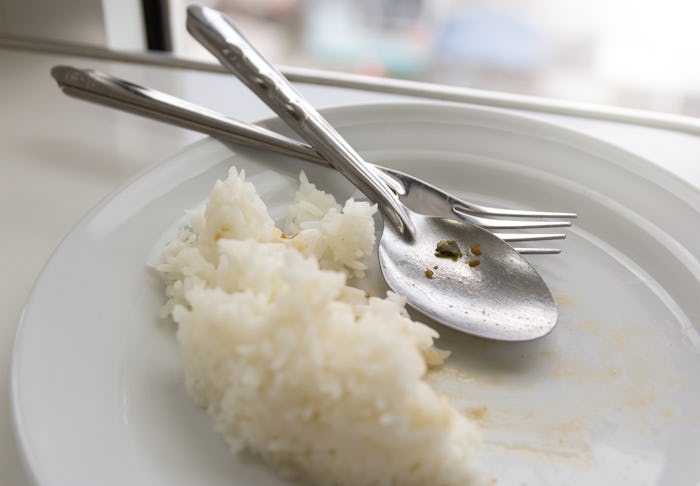News
Here's The Deal On Why Leftover Rice Could Potentially Give You Food Poisoning
Rice is a common staple in many homes, whether you're a big fan of stir-fry dishes or takeout Indian food. But despite the popularity of this dish, some people might not know that leftover rice isn't always safe to eat if it's stored incorrectly. Romper spoke with Tamika Sims, Ph.D., Director, Food Technology Communications at the International Food Information Council Foundation, who weighed in on this food safety concern that's been getting media attention lately and for best practices regarding leftover rice.
For busy families, leftovers are a must. It's not uncommon for parents to whip up a bunch of dishes on Sunday to get them through the week, and rice-based foods are perfect for this. But while you might not think twice about reheating a batch of rice for your mid-week meal, there could be hidden dangers.
It's first important to point out that the possible risk isn't due to reheating rice. The problem occurs when cooked rice has been left out at room temperature for too long because it can cause "spores of Bacillus cereus, a bacterium that can cause food poisoning," to flourish, according to the National Health Service in England.
"The longer cooked rice is left at room temperature, the more likely it is that the bacteria or toxins could make the rice unsafe to eat," the NHS' website states.
If you eat rice with Bacillus cereus present, you can experience "watery diarrhea and abdominal cramps, nausea, and vomiting," according to the U.S. Department of Health & Human Services.
To avoid these potential issues, Sims urges people to refrigerate their food soon after cooking. "Within two hours of cooking food (or after it is removed from the stove, microwave, etc.) leftovers should be refrigerated," she tells Romper. And before you refrigerate, let the rice cool down to room temperature (aka not piping hot), according to Live Strong.
The same rule applies for any foods that "come from a restaurant or market deli buffet are prepared similarly as they are prepared in homes," Sims explains. So, if you grab a to-go box from a Whole Foods buffet bar, make sure to eat it or refrigerate it within two hours.
Once your rice is safely stored away in the refrigerator, keep it in the fridge for "no more than one day until reheating," according to the NHS. If you reheat the rice within that one day timeframe, "check the dish is steaming hot all the way through" and "do not reheat rice more than once" advises.
If you're not sure how long a particular rice dish has been left out for, it simply "is better to not eat the food," Sims says.
If you're wondering about baby and kid foods that use prepared rice, Sims tells Romper, "These packaged foods should be prepared according to the label and once they have been cooked, they should be stored as noted above and then leftovers can be safely eaten as with other foods."
If you're concerned about safe food prep in general, it's best to follow the “Clean, Separate, Cook and Chill” method. Sims outlined this guideline, highlighting the three key components to this process:
- Properly wash your hands before you eat or prepare any meals.
- Handle any raw meat separately from your produce and dry goods, like rice. "For parents, this means washing their hands after handling raw meat and using separate cutting boards and utensils during meal preparation," Sims says.
- Be sure your food is cooked to a "proper internal temperature" and when you're to put them away, make sure they are stored and chilled properly.
Pretty easy, right? Once you incorporate this method into your daily routine, it should become second nature.
Food safety is a top concern for many families out there. If you still have questions about proper rice storage and other leftover rules, don't hesitate to reach out to a trusted medical professional.
